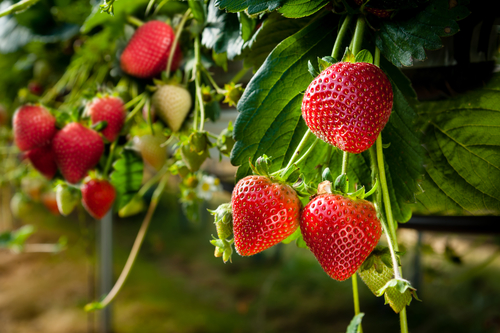
Clemson Extension agents provide updates in The South Carolina Grower this week about the status of various crops being produced throughout the state.
Coastal Region

Rob Last reports, “Crops are generally looking good in the area. Strawberries are coming to harvest with good volumes. Keep scouting for spider mites and thrips. Thrips were found late last week in low numbers. The threshold is 10 thrips per flower. A combination of good hygiene and effective fungicide sprays will be crucial. Other fruit crops are developing well elsewhere. We are also busy getting pickling cucumbers, watermelons and cantaloupes planted. Keep scouting brassica crops. We are finding increasing numbers of diamondback moth caterpillars in the area.”

Zack Snipes reports, “Cool nights are really impacting the early planted summer crops and strawberries. It seems the weather can’t decide what it wants to do, and the crops can’t figure out what they should do. I expect things to really push this week with a predicted week of beautiful weather ahead. The line of thunderstorms we got last week brought a good bit of wind that beat some crops up, but the rain was very much needed. The rain and warmer soil temperatures will drive weed seed germination, so be prepared to cultivate or get down some herbicides this week.”
Midlands

Justin Ballew reports, “We got another 2-to-4 inches of rain from the storms last week. I don’t think any of the tornados came through any produce farms in the Midlands, but I did see a pivot damaged by high winds. Our weather station near Newberry clocked a maximum wind speed of 54.3 mph Wednesday. We had some strawberries damaged by all the water, and the moisture created the perfect environment for botrytis development. Be sure to remove any damaged or diseased berries from the field to keep inoculum levels from building up. Sunday morning was very cool, and growers are reporting seeing frost in the fields. Our weather station in Lexington recorded a low of 31.8 degrees Fahrenheit, while areas north of Columbia got down into the upper 20s. Hopefully, this was the last one of the spring.”
Phillip Carnley reports, “Corn has been planted in Orangeburg and Calhoun and is already a few inches tall. Strawberries are still being picked. In my area, the production is highly variable, and I have seen a few nutrient deficiencies in nitrogen and magnesium. Make sure to take plant tissue samples to correct any nutrient issues accordingly. With the high volume of rain came a high occurrence of phytophthora and a decrease in spider mites. Mid- and late-season peaches are still being monitored for any signs of lingering cold damage. Muscadines are leafing out nicely, and now is the time to start prepping them for fertilization. It is early at the moment, but having Captan on hand for disease control of the more common leaf issues is advised, especially as the vines become more densely foliated and heat and humidity levels rise.”
Sarah Scott reports, “Last week brought us below-average temperatures and rainfall averaging 4 inches. Strawberries are recovering from the weather, and with many fields waterlogged, botrytis is showing up. Good field sanitation will be important in the coming days. Peaches are developing nicely. It still looks like we escaped terrible damage to mid-to-late season peaches. but we are keeping an eye out for fruit development. Summer crops like peppers and tomatoes have gone into the ground. They will be moving slowly after this weekend’s colder temperatures but with the forecast showing warmer
Pee Dee

Bruce McLean reports, “We have seen wind, rain, cool mornings, warm days, and patchy frost… and that was just this past week. Looks like most of the Pee Dee got a pretty good rain last week with some localized heavy downpours. Sunday morning brought another shot of cold air with some patchy frost. Hopefully, that will be the last chance of frost this season. Strawberries are looking good. Harvest is a little light. Spider mites are plentiful in some fields while being almost completely absent in others. Botrytis is widespread. Be sure to scout well for both. If spraying is necessary, be sure to rotate your pesticide chemistries. This will help guard against resistance. Blueberries are going to be very light at the beginning of the harvest season, in early-to-mid May. Blueberry harvest should improve by the time late May and June gets here. Blackberries and muscadines are looking good. Summer vegetable crops are either being planted or getting ready to be planted. There is a lot of activity in the fields at this time.”
Upstate
Andy Rollins reports, “We’re finding mites on almost all upstate strawberry plugs now with varying degrees of damage. Nealta gives a very good initial knockdown material for adults and can be mixed with some fungicides. Acramite and Kanamite are good ovicide or egg-killing choices. On some farms, we have had problems controlling populations even with both. Scout and make sure your leaves are clean. If you don’t have mite problems, the use of a miticide is a waste of money. The pest needs to be present for the material to be effective. Sclerotinia was also found on a strawberry farm. It is easily distinguished by the black sclerotia (Rice Krispies-looking) at the base of the plant. Cool, wet weather has encouraged this disease. Fontellis has performed well against this problem in the past.”










